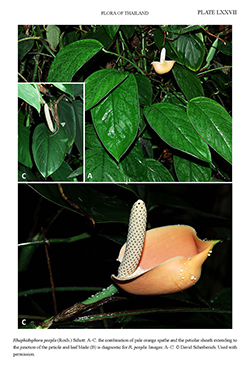e-Flora of Thailand
Volume 11 > Part 2 > Year 2012 > Page 280 > Araceae > Rhaphidophora
14. Rhaphidophora peepla (Roxb.) Schott
Bonplandia (Hannover) 5(3): 45. 1857; Prodr. Syst. Aroid.: 380–381. 1860; Engl. in A.DC. & C.DC., Monogr. Phan. 2: 242–243. 1879; Hook.f., Fl. Brit. India 6: 545. 1893; Engl. & K.Krause in Engl., Pflanzenr. IV, 23B (Heft 37): 41–42. 1908; Gagnep. in Lecomte, Fl. Indo-Chine 6: 1097. 1942; Hu, Dansk Bot. Ark. 23: 423. 1968; V.D. Nguyen. Araceae. Checkl. Plant. Sp. Vietn. 3: 893. 2005; Li & Boyce in H.Li. et al., Fl. China 23: 12–13. 2010.— Monstera peepla (Roxb.) Schott, Wiener Z. Kunst 1830(4): 1028. 1830.— Scindapsus peepla (Roxb.) Schott in Schott & Endl., Melet. Bot.: 21. 1832. Plate LXXVII.
Accepted Name : This is currently accepted.
Synonyms & Citations :
Description : Medium to large, moderately robust, leptocaul, homeophyllous secondary hemiepiphyte to 15 m. Stem terete, 8–12 mm diam. Leaves tending to cluster at shoot tips; petiole shallowly channelled, 10–20 cm; petiolar sheath reaching pulvinus, marcescent; leaf blade oblong-lanceolate to elliptic-oblong-lanceolate, 8–25 by 4–11 cm, apex abruptly acuminate or acute, base broadly rounded to sub-truncate; primary lateral veins many, striate, diverging at 45° from midrib; interprimary veins very slightly less conspicuous; secondary venation reticulate. Inflorescences solitary, terminal on lateral free shoots; peduncle robust, 8–10 cm, erect, upper part recurved, subtended by membranous cataphylls, these linear, 6–7 cm long, early caducous; spathe elliptic-oblong or oblong in outline, 7–9 cm long, gaping and then spreading at anthesis then caducous, dull orange outside, dull orange inside with the base stained yellow, apical rostrum ca 10 mm; spadix cylindrical, 5.5–8 cm long, ca ⅘ of total spathe, 10–2 mm diam., sessile, yellowish white to yellow. Infructescence stoutly cylindrical, 10–13 by ca 3 cm, initially green, later turning dull orange prior to stylar plates sloughing away.
Thailand : NORTHERN: Chiang Mai, Nan, Tak, Phitsanulok; NORTH-EASTERN: Loei; EASTERN: Nakhon Ratchasima; SOUTH-WESTERN: Kanchanaburi; CENTRAL: Nakhon Nayok.
Distribution : Nepal and NE India (type and type of Rhaphidophora manipurensis) through to N Myanmar and on to SW China.
Ecology : Evergreen montane to upper montane forests or mixed deciduous forests, on granite; 650–1,900 m alt.
Vernacular : Phlu chang (พลูช้าง), haen mum (แฮนมุม)(Loei).
Notes: As defined here, Rhaphidophora peepla is the commonest and most widespread Rhaphidophora in the north of Thailand. In the broad sense applied here it is readily identifiable by the broadly lanceolate leaves with rounded bases and the orange spathes. Rhaphidophora peepla belongs to a complex of trans-Himalayan species sharing similar morphology and spathe colouration, however; it is quite possible that there are several species involved in Thailand. See the above key, notably R. lancifolia and R. schottii.

